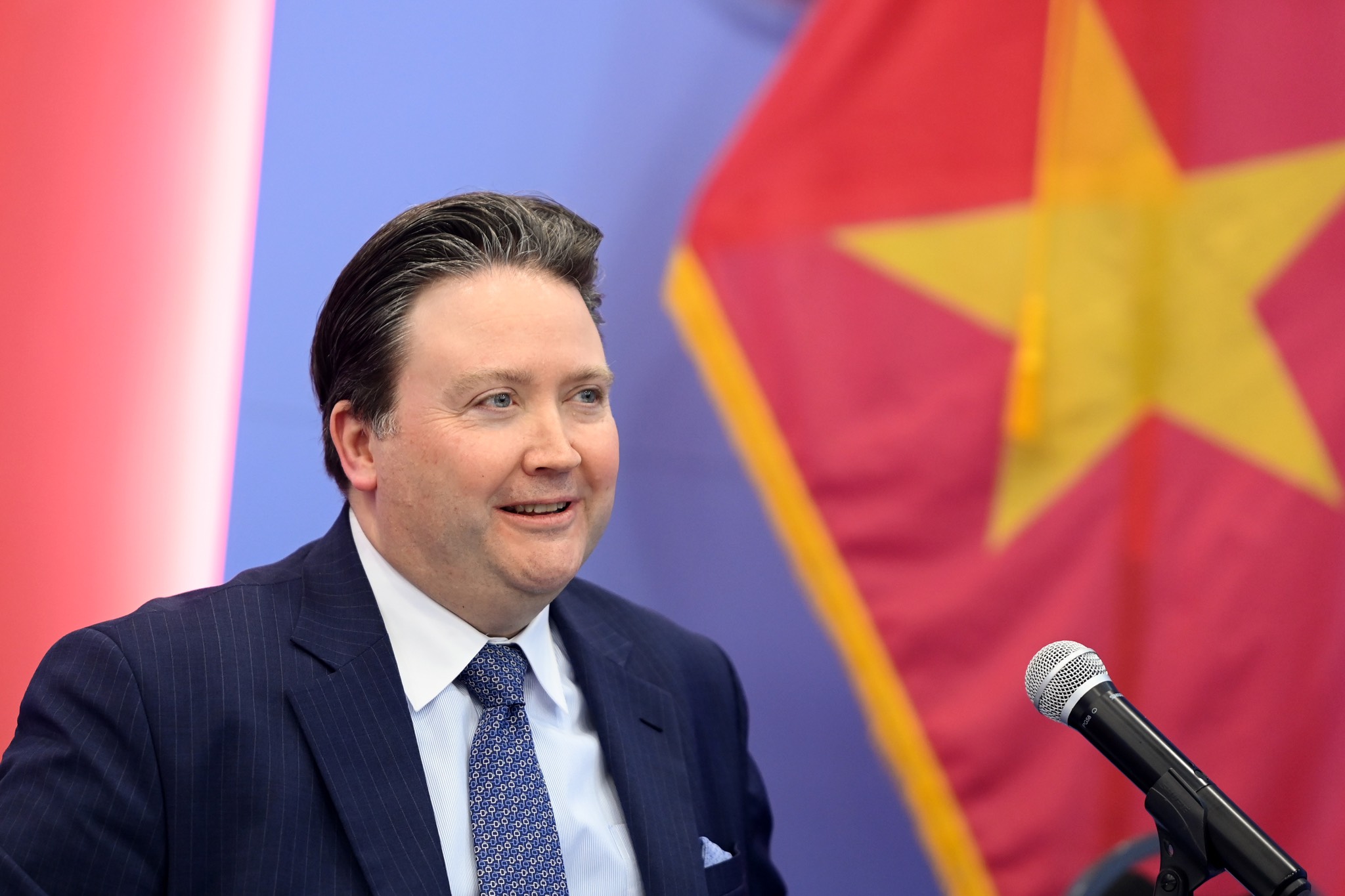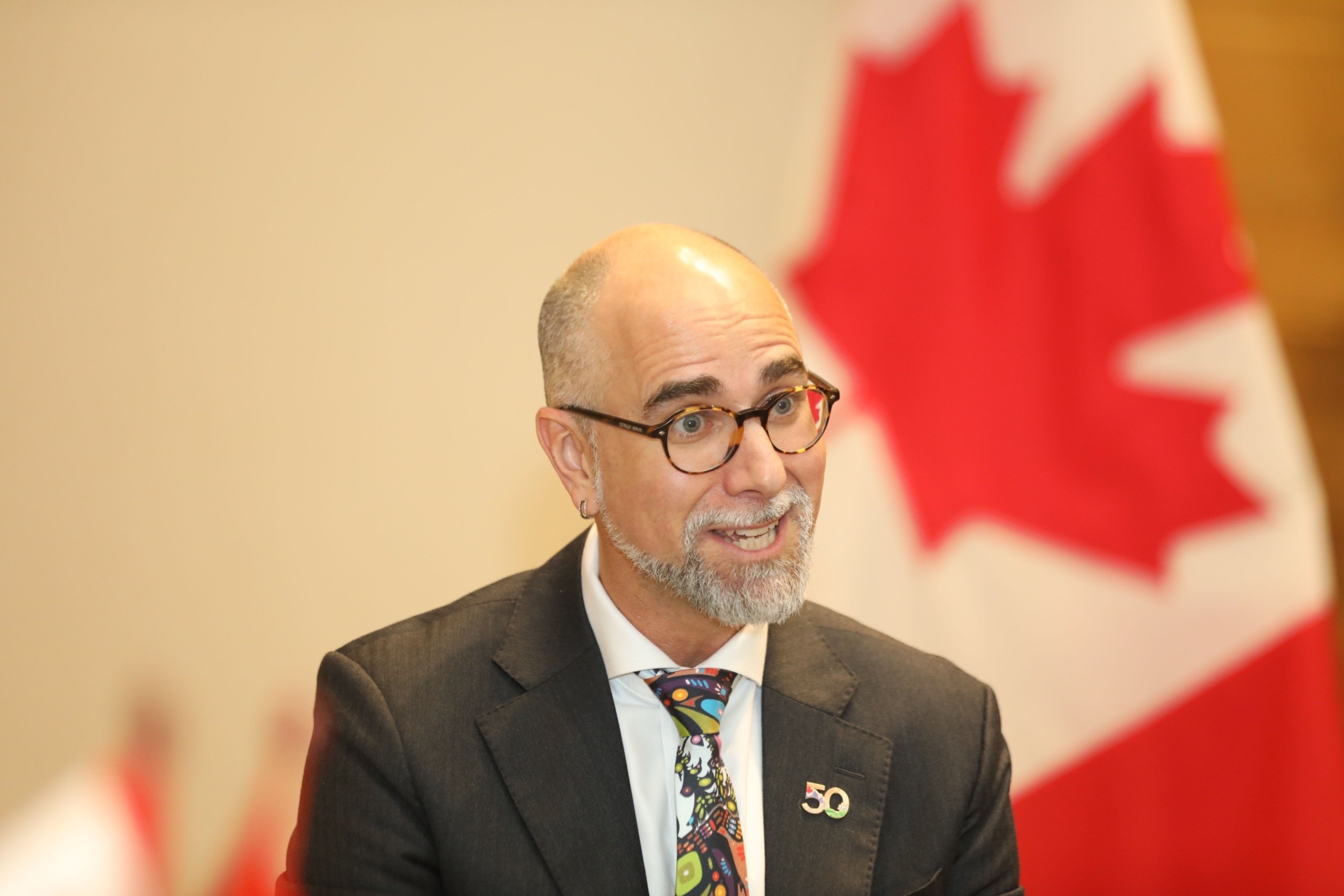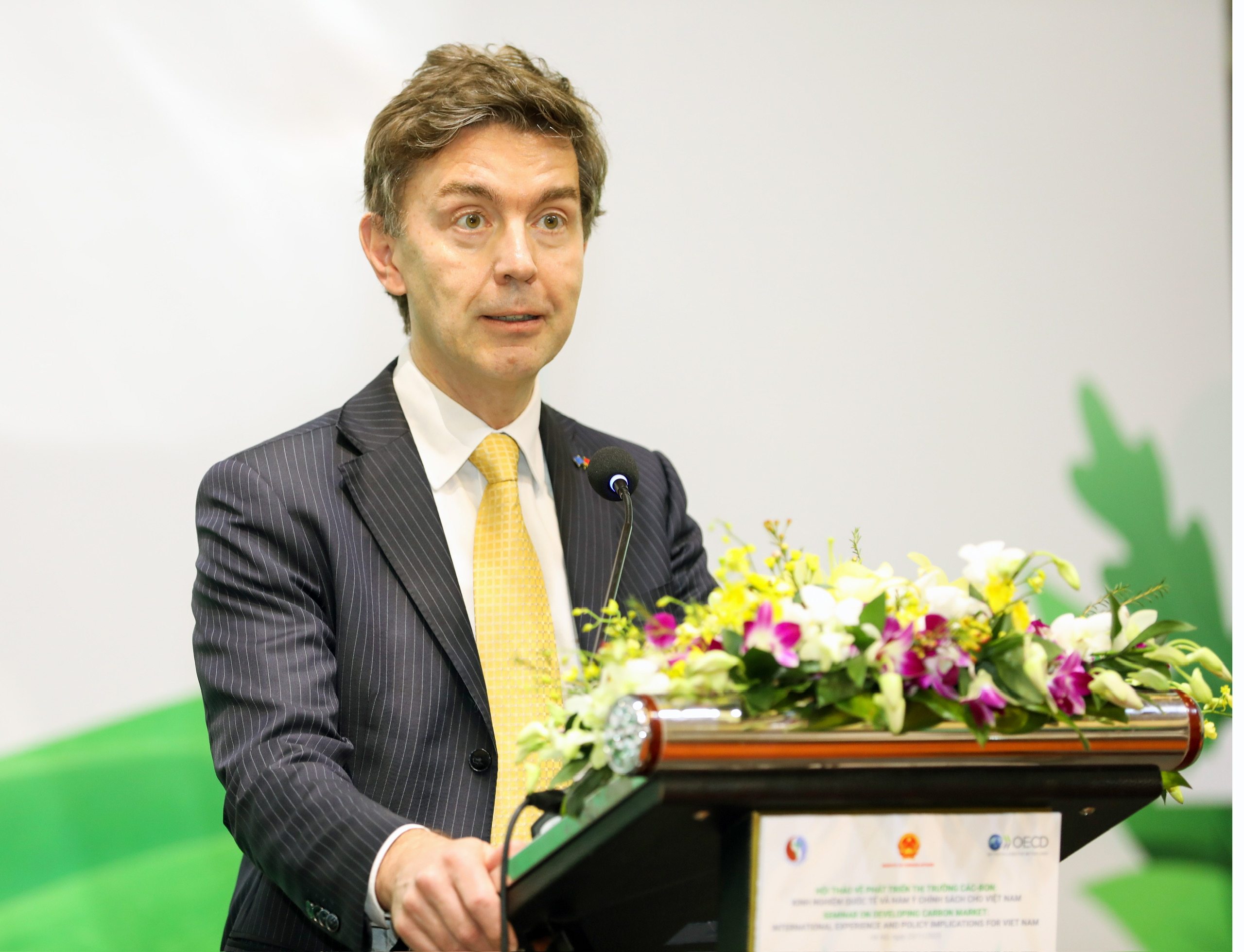US Ambassador to Vietnam, H.E. Marc Evans Knapper
Bilateral trade between Vietnam and the US has grown from less than $6 billion in 2003 to nearly $140 billion in 2022, and there is no reason to think that this trend will not continue. The US is not only Vietnam’s largest export market, but Vietnam is one of the US’s most important export markets for agricultural products like cotton and grains. As Vietnam makes progress toward its goal of becoming a high-income country by 2045, trade volumes will continue to grow.

There are many factors that drive trade between the US and Vietnam. Over the last several years, Vietnam’s role in global supply chains - from textiles to semiconductors - has grown both in scale and in importance. As we saw during the Covid pandemic, resilient and diversified supply chains are vital to the global economy, and US firms have continued to turn more and more to Vietnam to ensure that resiliency and diversity.
In turn, Vietnamese businesses and the country’s fast-growing consumer class are eager for world-class products and services from the US, from aviation and energy to technology, healthcare, and food. Vietnamese and US firms also trust the strength and stability of the US-Vietnam relationship. They see the same thing we do: the bilateral relationship has never been better and continues to get stronger every day. There was no better evidence of this than the visit to Vietnam by President Joe Biden in September and the subsequent announcement that he and Party General Secretary Nguyen Phu Trong had agreed to upgrade our relationship to a Comprehensive Strategic Partnership.
As Vietnam aims to move up the value chain, innovation and productivity will become increasingly important. Labor, technology, and streamlined regulations will occupy a central role in this regard. Training, education, upskilling, and reskilling efforts to ensure a high-quality workforce will be key to Vietnam’s success. The US is committed to working with Vietnam to achieve this. We have 30,000 Vietnamese people studying in the US each year, the number grows to 300,000 if you count all Vietnamese interacting with the US education system in some way, whether it is distance learning, short-term training, or other similar opportunities.
We expect these numbers to continue to increase. We have also launched new STEM education and training programs, as our governments agreed to do during President Biden’s visit. Another important factor is Vietnam’s energy transition and making tangible progress towards meeting its 2050 net-zero emissions goal. Vietnam’s transition to green and renewable energy sources will be essential to attract high-quality investment and boost bilateral trade. Once approved, the Direct Power Purchase Agreement will facilitate this investment. This is an area where not only businesses, researchers, and governments are innovating, but non-government organizations also play a key role to bring diverse perspectives to development in support of the goals of government.
When all of these elements work in concert, something like the transition to green and renewable energy is possible. We should also not forget the many Vietnamese in the US - the diaspora - who are increasingly seeking opportunities to return to Vietnam, expand people-to-people ties, and build business ties. The more support we can provide for them the better. They bring exactly the type of high-tech skills and innovation we hope to support the development of in Vietnam.
As previously mentioned, the trade and investment relationship between Vietnam and the US will only continue to grow. Whether it is American companies investing billions of dollars across many sectors - including semiconductors - in Vietnam, or a company like VinFast investing billions of dollars in a US manufacturing base for its electric vehicles and batteries - these are trends that were built on our earlier successes. Most US investors and firms that I talk to in Vietnam or in the US are positive about the trade and investment future between the two countries. I see no reason to doubt their optimism.
I understand that for many people, especially here in Vietnam, 2023 was a year marked by economic uncertainty amid difficult external conditions. However, I see that forecasters are issuing increasingly positive prospects for growth in the year ahead, and I am cheered by the fact that longer-term growth forecasts indicate Vietnam will continue to be one of the fastest-growing economies in the region. We have full confidence that Vietnam will live up to those projections, and we believe Vietnam’s success will translate to success for the US as well.
Canadian Ambassador to Vietnam, H.E. Shawn Steil
I think the statistics on bilateral trade for 2023 will be really strong. We had a record year in growth in our bilateral trade last year, over 30 per cent from 2021 to 2022. And I expect it’ll be even higher next year.
Two reasons quickly why I’m confident. One is that despite some economic difficulties over the past year, Canada’s consumption rate remained amongst the highest of the G7, so Canadians were still buying things and buying Vietnamese products. And second, I think we’re going to see significant growth in Canadian food exports to Vietnam, particularly in wheat.

For the past two years, Canadian wheat was not coming into Vietnam because of concerns over a common pest found in Canadian wheat fields. After deliberations by scientists on both sides, Vietnam has now met global standards and understanding that this is a non-risk pest and removed it from the list. So, Canadian wheat is now coming into the market again.
The prospect of that investment will make 2024 another big year. If you follow the trend rates, it will be great. I believe that investment follows the trend. So when exporters find that they have a market and they have partners in the market, then they start to think about investment. So our investment over the last year or two into Vietnam has been relatively stable, with small growth, but perhaps 2024 could see a breakthrough.
Talking about Canada’s Indo-Pacific strategy, Vietnam is one of the few countries where all the objectives of our strategy come into play. Whether it’s security, development, trade, environment and climate change, or simply advancing our political engagement, Vietnam is a focus of both strategies. That recognizes where Canada and Vietnam have developed our relationship across all those areas already, but where we see Vietnam being a crucial player in peace, security, development, and trade in the entire Indo-Pacific region.
Specific to defense and security, since 2020 we have started to develop a much more comprehensive relationship with Vietnam. That cooperation includes Canada’s support for Vietnam’s women peace and security agenda. It includes an MoU on peacekeeping where Canada will be boosting our support for Vietnam to play an important role in international peacekeeping.
On maritime security specifically, we have multiple ways in which we’re cooperating with Vietnam through the Indo-Pacific strategy. One, of course, is capacity building for the military of Vietnam. Both Vietnam and Canada recognize that the defense of international law, including the United Nations Convention on the Law of the Sea, is very important for maintaining peaceful maritime environments. A maritime security dialogue between the Ministries of Foreign Affairs will be launched in 2024.
Finally, it’s not always spoken about, but it’s also important to understand that the environment is an important part of maritime security. Canada has development assistance projects underway to facilitate smart coastal communities in Vietnam to adapt to climate change. In the Pacific strategy, we announced a shared ocean fund to support partners like Vietnam in the region to better manage fisheries. And we are engaged with Vietnam right now to discuss how we can provide that support.
Norwegian Ambassador to Vietnam, H.E. Hilde Solbakken
It is great to see our bilateral trade growing steadily. However, to be honest, it is still modest and there is room for improvement. An interesting fact, which might be good news for Vietnam, is that Norway imports more from Vietnam than it exports to Vietnam. Norway is importing many Vietnamese products including electronic equipment, footwear, and even seafood.
Trade promotion is therefore necessary in the coming years. Taking seafood as an example, Norwegian salmon has been well-known in Vietnam, and more seafood from Norway will be introduced to Vietnamese customers. We are both top seafood exporters in the world, and with different and complementary products, Norway and Vietnam can work together in this field to promote trade in both directions and expand the markets of both countries.

Concluding the negotiation of a free trade agreement between Vietnam and the European Free Trade Association (EFTA) bloc would be an important driving force to promote trade cooperation between the EFTA countries with Vietnam. This will also be a clear pathway for investments in Vietnam from Norwegian companies in green and blue economy sectors.
On November 25, 2023, we celebrated the 52nd anniversary of Norway-Vietnam diplomatic ties in a particularly memorable way with the official visit to Norway by Deputy President Vo Thi Anh Xuan. It was my pleasure to receive her and her delegation in Oslo, and then take part in her meetings and talks with Norwegian leaders, including Crown Prince Haakon Magnus, the Norwegian Prime Minister, the Norwegian Storting President, and the Norwegian Minister of Culture and Equality. The visit ended successfully with a joint press release from the two parties welcoming the significant development of bilateral relations between the two countries in recent years and expressing a firm intention to further strengthen and expand these relations.
During that visit, Prime Minister Jonas Gahr Støre and Vice President Xuan discussed the possibility of establishing strategic cooperation in the areas of green energy transition and sustainable ocean economy. This strategic cooperation will create new opportunities and provide a framework for both sides to enhance cooperation related to renewable energy, the circular economy, and blue economy activities.
I am very optimistic. The visit has been important to strengthen the diplomatic relations between the two countries and enhance our cooperation in different sectors including business and trade. I very much look forward to 2024 with this vision.
IMF forecasts show that Vietnam is predicted to be among the 20 fastest-growing economies globally in 2024, with projected GDP growth of 5.8 per cent. Against the backdrop of geopolitical turbulence in Europe and the Middle East, and the challenges that the global economy continues to face, including high interest rates, increased energy prices and a slowdown in the world’s major economies, we hope that Vietnam can make it.
Vietnam is home to over 40 Norwegian companies. Since my arrival to Vietnam a year ago, I’ve seen more interest in the Vietnamese market from Norwegian companies operating in the renewable energy, circular economy, and aquaculture sectors. With a Resource Mobilization Plan that Vietnam currently launched for the Just Energy Transition Partnership (JETP) between the G7, Norway, Denmark, and Vietnam, 2024 will mark the first year of its implementation. Offshore wind will likely be a priority area in the JETP. Norway’s contributions through JETP will come through the Climate Investment Fund (up to $250 million). These investments will depend on the regulatory framework and investment climate.
Regarding emissions reductions, co-processing and using non-recyclable plastic waste to replace coal in cement kilns is also a potential area of cooperation, as the cement industry accounts for 20 per cent of greenhouse gas emissions. Non-recyclable plastic waste can become a potential input material to replace coal, contributing to the energy transition process. Of course, cost and technology are prerequisite factors. But this can also be a potential area where Norway can support and cooperate with Vietnam.
In 2024, I do hope that Norway and Vietnam could ink an agreement on visa exemptions for diplomatic passport holders and establish the strategic cooperation in the areas of green energy transition and sustainable ocean economy. The latter might create more opportunities for our business cooperation in these areas.
Regular diplomatic engagement is essential. We have established close ties with local counterparts, and key decision-makers in areas where we work together. And we will continue our dialogues, political discussions, cooperation, and implementation of shared commitments.
We hope to be able to organize high-level visits both ways. With our shared interest and the kick-off of the JETP implementation, we will work together on expanding cooperation on green shifts and combating climate change as well as developing a sustainable ocean economy. We have seen our bilateral cooperation expanding daily - with renewable energy, circular economy, and aquaculture - at the government level and through the private sector.
People-to-people ties between Norway and Vietnam will continue with a series of cultural and educational exchanges. There were over 19,000 Norwegians visiting Vietnam in 2023, and we will hope to bring more to your beautiful country.
Ambassador of the European Union (EU) to Vietnam, H.E. Julien Guerrier
Since establishing diplomatic ties in October 1990, Vietnam has become one of the EU’s main partners in the region, with the highest number of agreements of any country in Southeast Asia, including the EUVFTA and the JETP. The EU and Vietnam have established cooperation in areas covering political issues, peace and security, global challenges, like climate change, trade, and development.
In 2012, the signing of the EU-Vietnam Framework Agreement on Comprehensive Partnership and Cooperation (PCA) marked the EU’s commitment to strengthening and broadening the scope of the mutually-beneficial partnership with Vietnam. The PCA, which entered into force in 2016, has continued to broaden the scope of EU-Vietnam cooperation in the areas of trade, environment, energy, science and technology, good governance, human rights, tourism, culture, migration, and the fight against corruption and organized crime. Since the publication of the EU’s Indo-Pacific Strategy in 2021, Vietnam has been seen as a key partner in the region.

Looking ahead to 2025 and beyond, I can say that Asia, and indeed Southeast Asia, is where the next century is being designed. In all pillars of our cooperation with the region, Vietnam has a very important role to play. We very much look forward to commemorating the milestone of 35 years of diplomatic relations with our partners in Vietnam across various sectors in 2025.
There are very bright prospects for economic and commercial relations between the EU and Vietnam. Trade, economic, and investment relations between the two have been built on a solid foundation. The EUVFTA has become an important aircraft lifting commercial links between the two economies to unprecedented heights. In 2022, the EU’s exports to Vietnam rose 18 per cent, and Vietnam’s exports to the EU grew even more impressively, by 33 per cent, according to figures from Eurostat. Such growth represents the highest bilateral export expansion between Vietnam and any trading partner during the year.
Bilateral trade has grown robustly since the implementation of the EUVFTA, only falling insignificantly in 2020 under the negative influence of the Covid-19 pandemic. To make a precise prediction about trends in the years to come, it is important to have an insightful look into the trade pattern of recent years.
Before the implementation of the EUVFTA, the average annual growth of Vietnam’s exports to the EU was 5-7 per cent, while that of the EU’s exports to Vietnam was 3-5 per cent. With the exception of 2020, amid Covid, bilateral trade ties have been growing strongly, in the double- digits. In 2021, the EU’s exports to Vietnam expanded by 21 per cent, while its imports from the country grew 12 per cent. This trend continued in 2022, with EU exports rising 18 per cent and Vietnam’s exports 33 per cent.
The past five years, from 2017-2022, which is two years before the implementation of the EUVFTA and three years after enforcement, have seen annual growth of 5 per cent on EU exports and almost 11 per cent for Vietnam’s exports, which is almost double the normal average annual in the absence of an FTA. I intentionally provide data for this five-year period to show how the EUVFTA has neutralized the negative impacts of crises and improved our trade relations.
Due to the very fast growth of our bilateral trade over the past years, we can expect some deceleration in growth. We have closely followed trade flows in 2023 and have indeed noted a declining trend in the trade pattern. From January to September, two-way trade shrunk by 7 per cent year-on-year, to €43.7 billion ($48.22 billion), according to Eurostat. Vietnam’s exports declined 6.8 per cent, to €35.3 billion ($38.95 billion), while EU exports fell 8.2 per cent to €8.5 billion ($9.38 billion). These figures signal some adjustment in the trading pattern of the bilateral commercial relationship in the context of a challenging global economic situation. I am of the opinion that such an adjustment may continue in 2024 before stabilizing and bouncing back strongly in 2025 and the following years.








 Google translate
Google translate